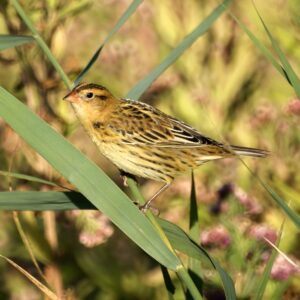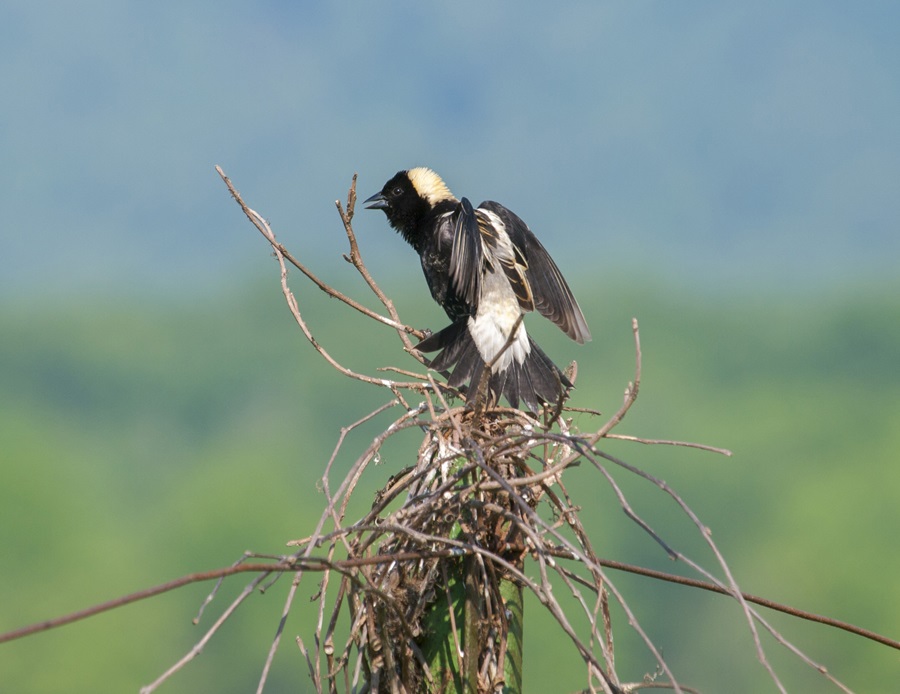Bink! The sound pinged overhead as I walked along High Toss Road in Wellfleet. It was a crisp early autumn morning, and the north winds overnight had dropped a smattering of fall migrants across the Cape. But while I watched vireos and warblers flit among the chickadee flocks, my attention was regularly drawn to that bink from flyover bobolinks.
Bobolinks are members of the blackbird family that breed in grasslands to the north and west of here. They get their funny name from the male’s loud, robotic-sounding song, whose crescendo — at least to some people — sounds like “bob-o-link.” The 19th-century poet and journalist William Cullen Bryant in his ode to the bobolink, “Robert of Lincoln,” describes the striking black-and-white male as a “prince of braggarts,” and the plainer streaky yellowish-brown female as his demure “Quaker wife.”
Bobolinks don’t breed on the Outer Cape, but they do show up regularly on their fall migration in September and early October, when males molt their bright plumage and adopt the females’ drab tones. You can find them roosting in overgrown fields and marshes with other blackbirds, but in my experience you most often see them flying overhead — if you look skyward after hearing that first bink call.

It’s unusual for a bird to be seen flying more often than it might be seen perching, feeding, or resting. But perhaps bobolinks are so often observed flying because they are so good at it. This bird’s migration is an astounding feat. Bobolinks breed as far north as Hudson Bay and migrate south, crossing the Caribbean Sea to reach the grassland llanos of Venezuela and Colombia. There, they congregate in massive flocks and feast on rice and other grains.
After a month or two refueling, the bobolinks continue south. They reach the Amazon rainforest and keep going. They don’t stop until they reach grasslands on the other side of the Amazon, sometimes as far south as Argentina. Then, come March and April, they turn around and fly back. That’s a more than 12,000-mile round trip.
There is no other North American songbird that flies so far every year. One tagged male that lived to be 10 years old must have flown at least the equivalent of five times around the equator during his lifetime.
In the mid-20th century, when ornithologists began seriously studying bird migration, such a traveler seemed like a great candidate for study. As early as the 1960s, ornithologists were trying to understand how bobolinks could navigate such long distances. But it wasn’t until the 1980s that ornithologist Robert Beason at the State University of New York at Geneseo finally began to crack the mystery: they orient themselves using a combination of the magnetic field of the Earth and the stars.
In an article published in Nature in 1984, Beason and his colleague Joan E. Nichols described taking a flock of 27 bobolinks and putting them in a planetarium at the beginning of fall migration.
When the stars in the planetarium matched with the stars outside, the birds hopped toward the southern end of the enclosure; they wanted to travel south for their fall migration. Then, Beason flipped the stars so that the north star was in the south. For a time, the birds kept hopping south, even though the stars were telling them they were going north, but after a few days they seemed to reorient according to the stars and began hopping north.

Beason concluded that these birds were using the magnetic field most of the time but would periodically reorient using the night sky. This might be akin to the way you navigate your town by memory but still check your direction every once in a while. Beason confirmed his findings by using powerful electrical coils to generate a flipped magnetic field in the planetarium, and the bobolinks started hopping the way that field dictated before switching with the stars.
But how could these birds sense the magnetic field at all? Beason thought there must be some organ in the bird that can detect magnetism. So, he dissected birds and found, nestled between the eyes, in the nostrils, and around the olfactory nerve, sheaths of magnetite, an iron oxide mineral — essentially tiny magnets that allow the bobolinks to sense the Earth’s magnetic field. Magnetite was later found in other migratory animals including turtles and whales, according to a 1999 article by Sharon Levy on the National Wildlife Federation website.
Beason’s research represented a breakthrough in the study of migration. Previous researchers had figured out that birds migrate using the Earth’s magnetic field, but Beason was the first to find the organ that a migratory bird used to sense it.
We don’t quite know how bobolink brains interpret the Earth’s magnetic field, but Beason’s later research suggests that these birds may sense magnetism visually — for instance, a Bobolink looking north might see the world tinted blue.
While they ably migrate by the night sky and the Earth’s magnetic field, however, bobolinks are struggling all along the way. These birds are tallgrass prairie breeders, and that habitat is vanishing rapidly across eastern North America because of agricultural intensification and development. On top of that, pesticides are killing off the food supply on their breeding grounds in South America, where farmers shoot them as pests.
According to data from the North America-wide Breeding Bird Survey, bobolinks experienced a continent-wide decline of around 2 percent between 1966 and 2013. Though that rate has slowed to a little over 1 percent in recent years, it still amounts to a dramatic loss: their population has dropped by more than 50 percent since 1966.
Once upon a time, the Outer Cape supported breeding bobolinks, but not anymore. A combination of fire suppression and reforestation filled in the open country on Cape Cod, where so many other grassland species once lived.
But the small patches of grassland habitat left here do seem to attract them. Last May, I spotted a male bobolink, adorned in its spring black-and-white plumage, perched on a goldenrod stalk at Fort Hill in Eastham. It sang loudly, a rich bubbly song that rang through that small patch of open country.
Bobolinks are inconsistent but annual visitors to Fort Hill in late spring, but they don’t seem to stay into the summer. One wonders if these birds are judging whether this patch of habitat is large enough to support a family before concluding that it’s not and moving on in search of greener pastures.
Perhaps that is another part of why bobolinks are always flying overhead. They’re looking to see if the grasslands where they once lived have come back yet.



